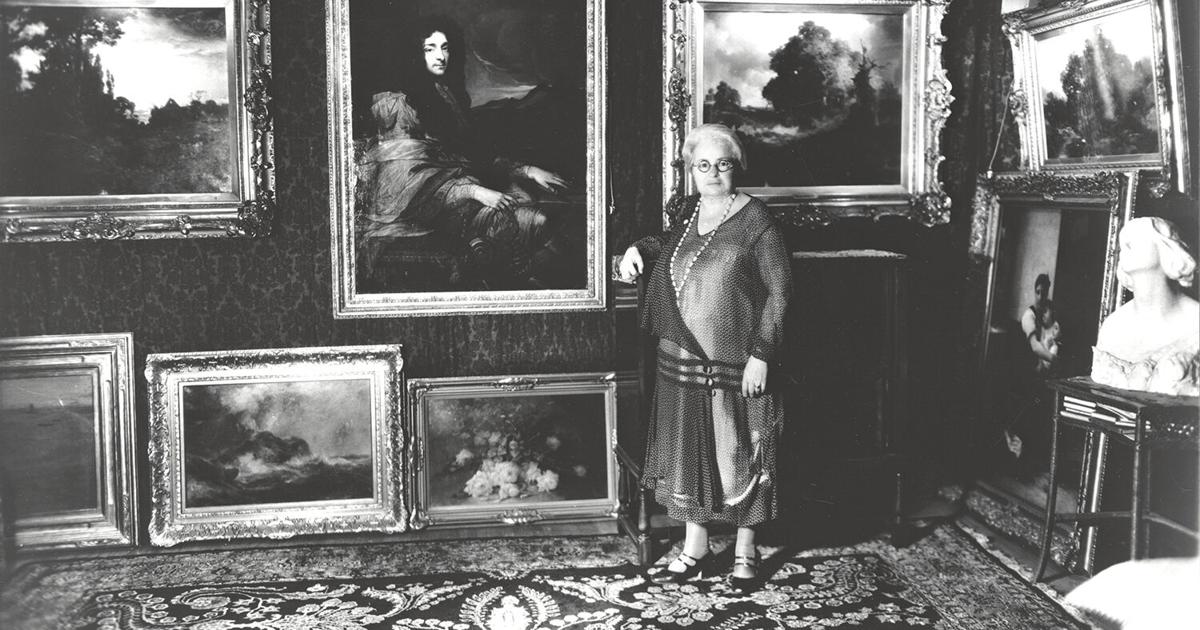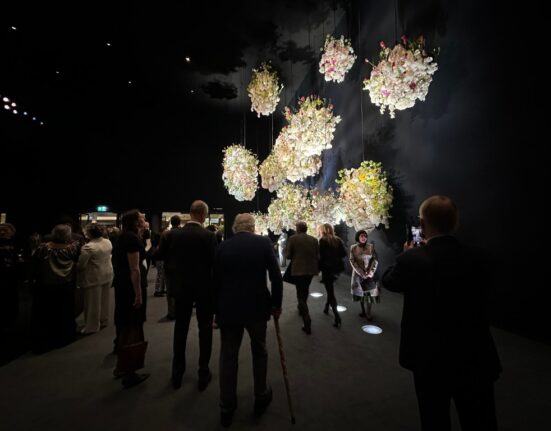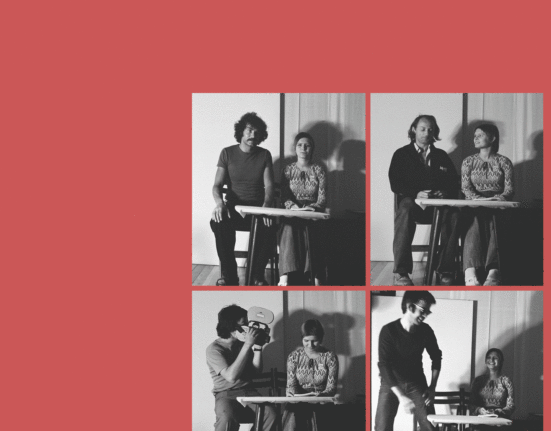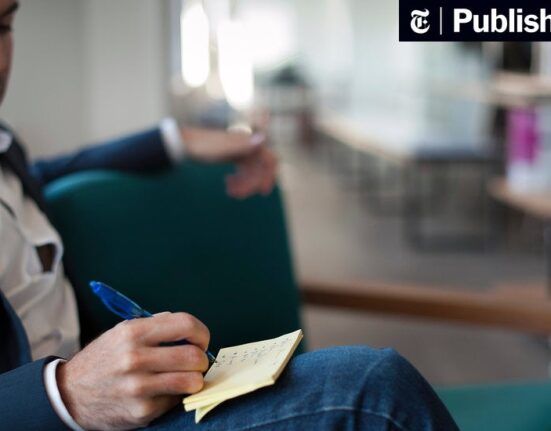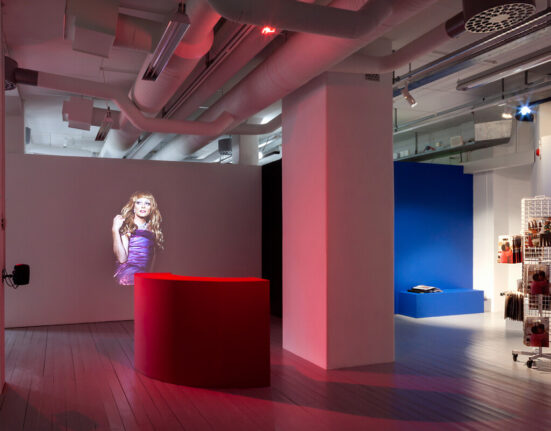This is a love story.
Multiple love stories, actually.
They begin with Susan Fuller Palmer, a newly minted docent at Philbrook Museum of Art. She never does anything lackadaisically. She catapulted from being a personal trainer to owning Firm by Susan Fuller, one of Tulsa’s earliest fitness centers. In preparation for a trip to France, she took college French classes and also became a certified sommelier in French wines.
So naturally she began her volunteer work at Philbrook with the ardor of a new love affair.
The first love story
Susan Fuller Palmer with “The Little Sheperdess.”
Palmer fell in love with “The Little Shepherdess,” an 1889 painting by William-
Adolphe Bouguereau. For decades the painting has been a pillar of the Philbrook collection and a longtime favorite of visitors, says Susan Green, who holds the solemn Philbrook title of Marcia Manhart endowed associate curator for contemporary art and design, who fizzes and bubbles with enthusiasm for art. Children copy the shepherdess’ costume for Halloween, Green says, and visitors mimic her pose.
And then Palmer noticed in tiny, tiny lettering on the identifying plaque that the painting was part of the Laura Clubb Collection. Who was Laura Clubb? What was her collection?
For information, she went to the Philbrook library and archives to research with the help of Saige Blanchard, library and collection information specialist. There she discovered another love story.
The second love story
Laura Abigail Rutherford was born in 1873 in Missouri. Her father came to Oklahoma Territory for the Run of 1889 and the family lived near Kingfisher. She was a 16-year-old teacher in a one-room, sod schoolhouse when she met a cowboy from the neighboring claim, Ike Clubb, 10 years older and wearing a 10-gallon Stetson. Two years later they married. He was no more than a boy when he left home in Arkansas to drive cattle herds. He wanted his own spread and was building his own herd. They moved to a corner of Osage and Kay Counties, acquired 1,280 acres of grassland and buckled down to the hard pioneer life.
Laura continued to teach school and as a rancher’s wife, cooked for the ranch hands and ran the ranch alone when Ike was away on cattle business. She took the weak, sickly calves Ike culled from the herd, fattened them to health and sold them back to him at $3 each. With that money and what she made selling chickens, eggs and butter, the 33-year-old woman who had been married 14 years went back to college in 1906 at Northwestern University in Evanston, Illinois. In 1908, she joined her much younger graduating class on a European tour of museums and galleries and saw, for the first time, great works of art.
Back home she taught oratory at Oklahoma State Baptist College in Blackwell. They kept the ranch, but moved into the town of Kaw City when their three adopted children were school age, and there she took in boarders.
Laura Clubb in 1906
Ike chose a prime tract of grassland in Kay County, but someone with political connections “rookie-dooed” him out of it, so he settled for an adjacent tract nobody wanted. (Author’s note: His leases were not illegally obtained Osage land. I checked.) In 1920 — oil! Frank Phillips said Ike’s 80-acre tract was “the richest in the (Burbank) Field.” The tract he first chose had no oil.
In what seems a remarkable marriage of equality for the time, Ike and Laura agreed to split the oil profits 50-50. Ike used his share to buy more land and cattle, Arabian horses, an orchard in Texas and to develop Kaw City where in 1924 he built a four-story hotel at a cost of $136,600 — $2.3 million in today’s cash equivalent.
Laura spent her oil money on art.
She had pinched pennies; now she bought rare books, antiques and fine linen. Paintings were her first love and she bought hundreds of them, accumulating one of the finest private collections of American and European paintings in the world. Much of her collection was European (Joshua Reynolds,
Bartolomé Esteban Murillo, John Constable, William Hart) but she also bought Oklahoma paintings (Nan Sheets, Frederick W. Becker, Oscar Jacobson, Emil W. Lenders) and other Americans (George Inness, Thomas Moran). She owned more Moran paintings than any collector and filled two hotel rooms with them, including her favorite, “Grand Canyon.”
The Clubbs decorated their new home in Kaw City floor to ceiling with paintings until the art overflowed into the Clubb Hotel and filled it. The one-street town with a peak population of 1,001 became famous for Laura’s art collection.
Hotel residents could rent a room for $2 a night, spend 75 cents for a meal in the dining room and look at a $50,000 Thomas Gainsborough (“Milking Time”) for nothing. People from all over the world streamed through the hotel, open 24 hours a day, free of charge to see the art. Sundays drew 500-1,000 people. If they wanted more information, Laura took off her apron and walked over to the hotel to give a private tour. Newspaper reporters described her as charming, gracious and motherly. She certainly looked it with her puff of white hair and a figure as soft and round as a pudding.
Laura had always been vivacious and outgoing with a beautiful voice and a gift for storytelling. Ike was a quiet, dyed-in-the-wool cowboy who loved his horses and never learned to drive a car because the contraption didn’t understand “Whoa there.” He was a member of the Cherokee Strip Cowpunchers Association, friends with Gordon W. “Pawnee Bill” Lillie and Zack Miller of the Miller Brothers 101 Ranch. Sometimes he and other old cowpokes retreated to a private space at the hotel filled with a buffalo hide and cowboy memorabilia and sipped “snake medicine.” When Laura bought a pastoral painting by Émile van Marcke for $12,000, he laughed, “For that amount I could have bought a train car of cattle.” But he was proud of her and her accomplishment. Laura never learned to drive either; she had a chauffeur.
As she aged, Laura made plans to secure her collection after her death. She was a pioneer who loved Oklahoma and wanted it to stay in Oklahoma, said her granddaughter Annette Pittman, now 92 and living in Texas. Laura offered the collection to Ponca City, but town fathers said they would accept it only if she built a building for it. “She was so disgusted, she got up and left,” Pittman says.
Laura tried to loan it to Oklahoma City’s new Historical Society, but the official in charge, former Gov. Robert L. Williams “made a fuss,” Laura said, about insuring it. He thought a fireproof building with guards on duty was sufficient safety.
Philbrook hosted a dinner for Laura Clubb (pictured upper left) when she donated her collection.
And so, in 1947, she donated 86 paintings, and many rare books, to the young Philbrook Museum of Art, a gift to the city of Tulsa by Waite and Genevieve Phillips that had opened eight years earlier. It was transformative, one of the museum’s largest gifts and, according to Thomas Young, Philbrook’s librarian/assistant registrar, the backbone of the museum’s collection. Some reports said its appraised value was about $1.5 million (almost $14 million in today’s purchasing power). Philbrook kept some paintings and sold others to fund upgrading its collection. Philbrook still has 59 paintings from the Clubb Collection.
The third love story
One painting not included in her donation was “Christ and the Children”by Franck Kirchbach, a public favorite. At 9.5 feet by 12.5 feet, it covered an entire wall of the hotel. In 1950, she agreed to sell it to a group of Tulsans — Mrs. Eugene Lorton, Mrs. F. B. Parriott and Mr. and Mrs. John Zinke — who bought it for Philbrook. Young speaks reverentially of that long-dead generation. This is the third love story: community-minded citizens with a love for a cultural institution.
Philbrook was managed at the time by Victor C. Hurt, a former football coach (Oklahoma Baptist University and University of Tulsa) known as “the gentleman coach.” With more public decorum than art knowledge, he had clothing painted on the naked children in the painting. Laura “hit the ceiling,” her granddaughter said, and made them repaint it.
Years later during a renovation, the massive painting was taken down, stored and eventually sold. By 1952, another painting from the Clubb Collection rose to take its place in popularity: “The Little Shepherdess.”
The fourth love story
Philbrook Museum vistors view William-Adolphe Bouguereau’s “The Little Shepherdess.”
Each February, Philbrook visitors are given a paper heart to lay on the floor below their favorite work of art, curator Green says. Some “tear their heart into pieces to spread the love around.” In recent years, Kehinde Wiley’s “Equestrian Portrait of Philip IV,” a 2017 acquisition, has received the most hearts. “The Little Shepherdess” is a close second. Last year, a top contender was Worthington Whittredge’s “Morning in the Woods,” another painting from the Clubb Collection. “Laura had an eye for art,” Green says, “and a heart for art.”
Laura died Jan. 13, 1952, at age 78. Ike had died four months earlier. In the late 1960s, with the Arkansas River’s Kaw Dam near completion, Ike’s beloved hotel was demolished and Kaw City was flooded.
The hotel is gone, the original town is gone, only Laura’s paintings live on in fact and in the hearts of the public.
So does docent Palmer’s love affair with Laura Clubb, Bouguereau’s shepherdess and Philbrook. Being among the museum’s collection, she says, “takes me out of my daily routine and into an alternate universe.”
The museum loves its docents right back. “They are crucial,” says Melissa Ski, manager of tours and school programs, “vital to our mission and some of the most dedicated people I have worked with. I say that out of my heart.” That is the fifth love story.

